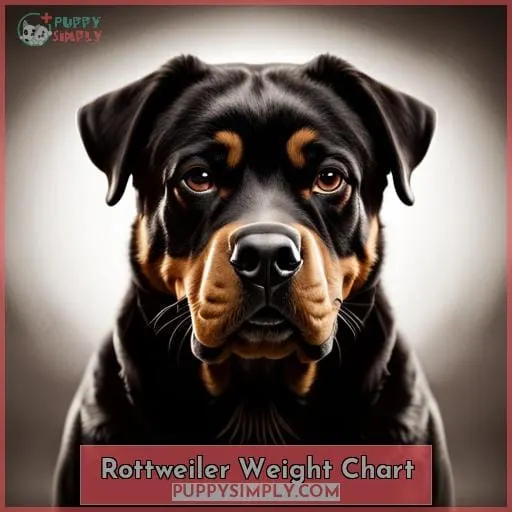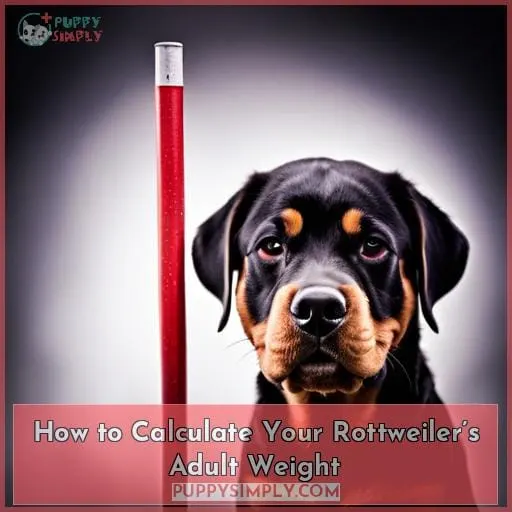This site is supported by our readers. We may earn a commission, at no cost to you, if you purchase through links.
Are you curious to know how big your Rottweiler pup will be fully grown? A Rottweiler’s weight and height are mainly determined by genetics, but there is a growth chart that can help you estimate the size of your adult dog.
This article will provide information on a Rottweiler Growth Chart, Weight Chart, and Height Chart for both male and female dogs.
Get ready to learn all about growing up with a Rottie!
Table Of Contents
- Key Takeaways
- Rottweiler Growth Chart
- Rottweiler Weight Chart
- Rottweiler Height Chart
- At What Age is a Rottweiler Full Grown?
- How Big Should a 6-month-old Rottweiler Be?
- How Much Bigger Will My Rottweiler Get?
- What is the Size of a Full-grown Rottweiler?
- Rottweiler Growth Stages
- How to Calculate Your Rottweiler’s Adult Weight
- What is the Average Weight of a Full-Grown Rottweiler?
- Frequently Asked Questions (FAQs)
- Conclusion
Key Takeaways

- Rottweiler growth is determined by genetics and can be estimated using a growth chart.
- Rottweilers typically reach their full size at two years old, but some may continue growing until three years old.
- Male Rottweilers can weigh between 95-135 lbs and reach a height of 24-27 inches, while female Rottweilers typically weigh 80-100 lbs and are 22-25 inches tall.
- Proper nutrition, exercise, and veterinary care are crucial for healthy growth and development in Rottweilers.
Rottweiler Growth Chart

By monitoring your pup’s weight and height, you can track their progress towards reaching their full size – which they typically reach at two years old for medium-sized breeds. Genetics play a major role in determining the adult weight and height of Rottweilers, but dietary needs, exercise requirements, pet insurance coverage for vet appointments, and emergencies also come into play.
The following numbers will give an indication of how big a Rottweiler puppy should be growing to:
- 6 months old male – 64-71 lbs; 22-23 inches tall
- 6 months old female – 63-68 lbs; 22–25 inches tall
At 9 months, males should weigh 82-98 lbs and be 24-26 inches tall. Females, on the other hand, should be slightly smaller, weighing 83-99 lbs and measuring 24-26 inches in height.
Pet parents should keep in mind that large breed puppies tend to grow more rapidly between birth and 5-7 months. Therefore, special attention is needed in terms of diet and activity level, as overfeeding can be dangerous, especially with larger breeds like Rottweilers.
It’s worth noting that German Rottweilers may grow slightly bigger than American ones due to differences in working line or show lines. Additionally, it’s important to remember that neutering or spaying should be done after the dog has finished growing.
Rottweiler Weight Chart
Understanding the growth and weight of your Rottweiler is essential for their health and well-being. Male Rottweilers can grow to weigh between 95-135 lbs at two years old, while females typically reach 80-100 lbs in the same time frame.
Tracking these numbers throughout a puppy’s life will help owners determine when they have reached their full size or if any potential issues arise that need medical attention. To better understand a Rottweiler’s development, it is important to look at both male and female growth charts as well as other factors such as diet, exercise needs, neutering/spaying age, etc.
Male Rottweiler Growth and Weight Chart
You can easily track your male Rottweiler’s growth and weight progress with the help of a chart. Male size, weight expectations, bone structure, puppy diet, and regular veterinary visits should all be taken into account when considering optimal development.
A six-month-old male Rottweiler should weigh between 64-71 lbs and stand about 22-23 inches tall. At one year old, they will reach their maximum height but continue to grow in terms of bulkiness until they are three years old.
Pet parents must ensure that their puppies are fed properly throughout this period for optimum health. Large breed-specific puppy food is recommended, as well as an orthopedic dog bed to support growing bones.
When it comes to males reaching full size, genetics play a major role combined with proper nutrition and exercise practices.
Female Rottweiler Growth and Weight Chart
Tracking your female Rottweiler’s growth can be a challenging task, but the right chart should provide an accurate estimation of her adult size and weight.
Notably, females tend to reach their maximum height around one year old, while males may take up to three years.
When it comes to female puppies’ development, weight gain is strongly influenced by genetic factors as well as diet and activity levels.
Regular veterinary care is essential for prevention and early detection of hip dysplasia risks, which increase after 6-8 weeks of age.
The average weight for full-grown females ranges between 80-100 lbs., slightly smaller than their male counterparts who weigh 95-135 lbs.
Neutering or spaying should be done after bone growth has finished to avoid any long-term complications due to health issues such as hip dysplasia or heart disease, which are common among Rottweilers.
Rottweiler Height Chart
Understanding your Rottweiler’s height is just as important as their weight when it comes to assessing overall health and development. Genetics, diet, exercise needs, and the neutering process play a key role in determining the growth of a Rottweiler puppy.
It’s recommended that pet owners get insurance coverage for routine care and wellness check-ups so they can be prepared for any eventuality. According to the AKC breed standard, male Rottweilers should reach 24-27 inches tall at adulthood, while female adults are usually between 22-25 inches tall in size.
| Age | Height (inches) | Weight (lbs) |
|---|---|---|
| 6 Months | 22–23 | 64–71 |
| 9 Months | 24–26 | 82–98 |
Puppies double their birth weight during the first week of life before slowing down over time until reaching six months old, where they typically weigh 30% of adult bodyweight but only 60% of adult height.
At seven months old, full-grown males weigh 79-99 lbs with heights from 24-26 inches, while females tend to range slightly lower than this at 82-98 lbs with heights from 23-25 inches respectively.
Providing regular veterinary attention, including screenings for hip dysplasia, is essential, along with choosing appropriate foods based on breed size since overfeeding can lead to dangerous consequences, especially among large breeds like German or American Rottweilers.
Lastly, look out for signs such as palpability in the rib cage area, which will indicate whether an individual pup has reached its ideal body condition yet or not.
At What Age is a Rottweiler Full Grown?
Most Rottweilers are considered full-grown between 12 and 18 months, although some may continue to grow until they reach 3 years old. For example, Jack’s Rottweiler pup reached its full size at 15 months but continued to fill out in muscle tone for another 6 months.
Genetics play a major role in the final size of a large-sized dog breed like the Rottweiler. However, diet considerations and exercise needs can also have an impact on growth stages as well as overall health.
Veterinary care is essential for monitoring puppy weight predictions while ensuring vaccinations remain up to date for both giant breeds and smaller ones alike.
Overfeeding should always be avoided due to potential hazards associated with obese dogs, such as being prone towards hip dysplasia or other joint issues that could arise later on down the road if not managed properly from an early age onwards.
When looking at your pet’s rib cage area, you should see visible distinction from all other parts of their body when viewing them from above.
How Big Should a 6-month-old Rottweiler Be?
At six months old, you can expect your Rottweiler to be roughly two-thirds of the way towards their adult size and weight. Male Rottweilers at this age should weigh between 64-71 lbs and stand about 22-23 inches tall, while female Rottweilers usually reach a height of 22-25 inches with an average weight of 82 to 98 pounds.
Feeding habits, exercise needs, and genetics all play a role in determining the ultimate size of your pup.
It is important to remember that large dog breeds like German Shepherds or Labrador Retrievers tend to grow faster than smaller breed dogs such as Shih Tzus or Chihuahuas. Therefore, they may require more attention when it comes to monitoring their growth progress throughout each stage.
Pet insurance can also help cover any medical emergencies due to genetic issues like hip dysplasia or heart disease, which could arise later on down the road if not managed properly from an early age onwards.
Growth plates are another major factor when predicting how big your pup might become over time.
How Much Bigger Will My Rottweiler Get?
By monitoring your Rottweiler’s progress with regular vet appointments and a balanced diet, you can ensure that it reaches its full potential in terms of size and weight. Genetics play a major role in determining the ultimate size of your pup, with German lines typically being larger than American lines.
Diet requirements should also be taken into consideration as large breeds are prone to obesity if overfed. Exercise needs vary depending on the type of line; working dogs will require intense physical activity whereas show-lines may need less rigorous exercise regimes.
Pet insurance is essential for providing coverage against any unforeseen medical conditions such as hip dysplasia or heart disease, which could affect their growth rate later on down the road too.
When considering a Rottweiler’s growth chart, there are several key points to keep in mind. Genetics influence adult weight and height significantly. Females tend to be smaller than males. Diet plays an important part in maintaining the best quality health for purebred dogs.
Regular exercise helps towards achieving total weight goals faster but not at the expense of overexertion either side.
Finally, neutering or spaying after bone growth has finished is advisable, while paying close attention to rib cage palpability plus waist visibility when viewed from above.
What is the Size of a Full-grown Rottweiler?
You can expect a full-grown Rottweiler to reach heights up to 27 inches and weights of around 135 lbs, like an ancient warrior ready for battle. But the path they take from puppyhood to adulthood varies between males and females as well as different lines such as German vs American.
Genetics play a major role in their size, with females typically being smaller than males. However, diet selection, exercise needs, and other factors also influence their weight gain.
The key is monitoring your pup’s health closely during growth spurts – sudden changes could be signs of something more serious, so seeking veterinary support is recommended. Diet plays an important part in ensuring that they don’t become overweight or underweight.
Large breed-specific foods are advised due to them needing extra nutrition compared to smaller dogs.
Exercise requirements vary depending on the type of line. Working dogs will require intense physical activity, whereas show-lines may need less rigorous exercise regimes.
Finally, pet insurance can provide coverage against any unforeseen medical conditions that could affect your Rottweiler’s growth rate later down the road too.
Rottweiler Growth Stages
Growth is an important part of a Rottweiler’s life cycle. At 1 week old, they typically weigh between 4-8 lbs. At 3 months, they can attain up to 60% of their adult height and 30% of their weight. By 7 months, they usually reach around 24-26 inches in size, with weights ranging from 79-99 lbs.
Week Old Rottweiler
Discover the incredible transformation of your pup in just a few weeks as they double their size and start to look more like an adult Rottweiler! Feeding habits, exercise needs, genetic factors, and veterinary care are all key components for ensuring healthy growth.
Neutering/spaying should only be done after bone growth is finished. Genetic diseases can also affect them, so regular diagnostic work-ups and preventive measures must be taken to ensure wellness coverage.
3 Months Old Rottweiler
At 3 months, your pup is 60% of their adult height and 30% of their weight – males are usually bigger than females. Feeding requirements vary based on breed standards, and health concerns should be monitored.
Size differences influence growth rate, while police work requires proper exercise needs for teenage years.
7 Months Old Rottweiler
By 7 months, your pup is likely to weigh 79-99 lbs and stand 24-26 inches tall. Feeding habits are critical for proper growth; exercising them according to breed lines will ensure peace of mind.
9 Months Old Rottweiler
You’ll be amazed to see just how much your pup has grown in the past three months! At nine months, a Rottweiler can weigh 82-98 lbs and stand 24-26 inches tall. Exercise needs and diet control are essential for proper growth, even with genetic predisposition; weight gain must be monitored by responsible owners.
Veterinary care is key, with screenings like aortic stenosis, plus general rules from Veterinary Centers of America regarding bone structure.
Months Old Rottweiler
Experience the joy of watching your pup grow and develop as they reach each new milestone! From puppy food to veterinary care, monitor a Rottweiler’s growth rate for health reasons. A young dog’s predisposition to hip dysplasia, heart disease, and size can be managed with the right resources.
How to Calculate Your Rottweiler’s Adult Weight
Knowing your Rottweiler’s adult weight can help you plan ahead and give them the best care possible.
- Feeding habits play an important role in a dog’s growth. Make sure that you provide them with the right nutrition and avoid overfeeding—especially for large breeds like Rottweilers!
- Regular veterinary appointments are necessary to ensure health concerns such as hip dysplasia or heart disease can be addressed promptly with pet insurance coverage if needed.
- Growth plates typically close around 12-18 months but may take up to 3 years depending on breed type (e.
- Finally, genetics will always play an influential role when it comes down to predicting adult weights at the end of the day; however, diet and activity level still remain key factors that will determine whether or not your dog reaches its full potential physique-wise as well as health-wise throughout its lifetime journey towards adulthood.
What is the Average Weight of a Full-Grown Rottweiler?
Understanding the average weight of a full-grown Rottweiler is key to ensuring that your pup reaches its potential in terms of size and health. Genetics play an important role when it comes to predicting their adult weight, but diet needs and exercise requirements are also essential factors for them reaching their goal size.
Male Rottweilers generally reach 95-135 lbs at two years old, while female ones usually weigh 80-100 lbs at this age range – though these numbers can vary depending on several factors such as nutrition, activity level, or genetics! Additionally, they tend to be larger than other breeds due to being descendants of the massive Asian Mastiff.
Hip dysplasia is common within this breed, so taking extra care with feeding habits and providing regular veterinary check-ups will help keep up with any health issues that may arise throughout adulthood stage.
Knowing a rough idea about their size beforehand will give you peace of mind, knowing that you have taken all necessary steps towards making sure your furry companion has everything he/she requires for optimal growth until they reach adulthood – which could take anywhere from 12 months up until 3 years depending on individual cases.
Frequently Asked Questions (FAQs)
What is the life expectancy of a Rottweiler?
The average life expectancy of a Rottweiler is about 9-10 years. However, with a proper diet and exercise, they can live up to 12+ years in good health.
Are there any health concerns associated with Rottweilers?
Yes, there are health concerns associated with Rottweilers. They can be prone to hip dysplasia as well as heart disease, such as aortic stenosis. Regular vet visits and monitoring diet and activity levels are important for maintaining their overall health.
Pet insurance may help cover the costs of emergencies or treatments needed due to genetic diseases.
What type of food should I feed my Rottweiler?
Feed your Rottweiler a large-breed specific puppy food to give them the best start. Monitor their growth and talk to your vet about nutrition for healthy development, as they can be prone to hip dysplasia.
What is the best way to train a Rottweiler?
Train your Rottweiler with positive reinforcement, consistency, and patience. Give them praise for good behavior and use treat rewards to reinforce commands. Utilize short training sessions so as not to overwhelm the pup while gradually increasing difficulty levels for obedience drills.
Does a Rottweiler require a lot of exercise?
Yes, Rottweilers require regular exercise to stay healthy. Their size and energy levels mean they need more than other breeds. Take them on walks or runs in the park, play fetch with a ball or Frisbee, engage in activities like agility training – there are plenty of options! Exercise will help keep your pup fit and content.
Conclusion
Congratulations on making it this far! You’ve done an excellent job of understanding the complexities of a Rottweiler’s growth chart. Now, with all the knowledge you’ve acquired, you’re ready to be the best Rottweiler parent possible.
You can be sure to provide your pup with the best nutrition, exercise, and veterinary care to ensure their health and happiness.
With the right care and attention, your Rottweiler will be a happy and healthy companion for many years to come.















